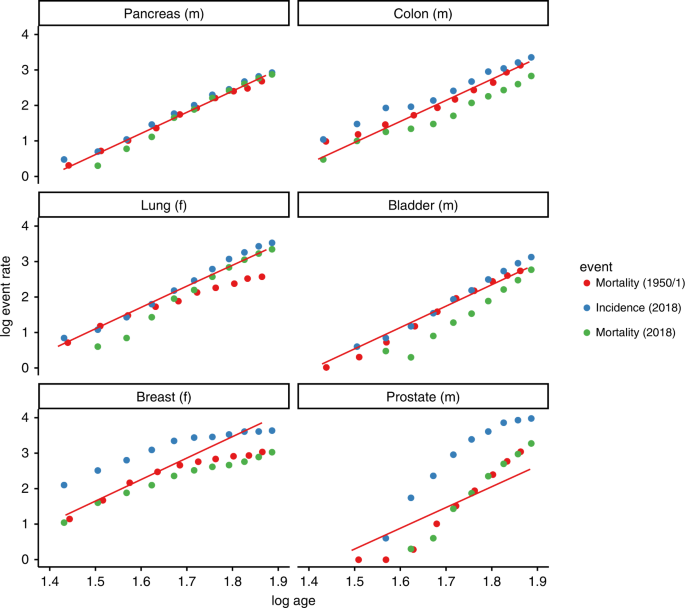
Age distribution and a multi-stage theory of carcinogenesis: 70 years on
- Select a language for the TTS:
- UK English Female
- UK English Male
- US English Female
- US English Male
- Australian Female
- Australian Male
- Language selected: (auto detect) - EN
Play all audios:

ABSTRACT The Armitage Doll model demonstrates that the impact of age-dependent exposure to carcinogenic factors depends on whether the induced change occurs early, at the midpoint or late in
carcinogenesis. 70 years on, updated modelling shows that their epidemiological observations still provide insight into clinical observations and their underlying molecular mechanisms.
Access through your institution Buy or subscribe This is a preview of subscription content, access via your institution ACCESS OPTIONS Access through your institution Subscribe to this
journal Receive 24 print issues and online access $259.00 per year only $10.79 per issue Learn more Buy this article * Purchase on SpringerLink * Instant access to full article PDF Buy now
Prices may be subject to local taxes which are calculated during checkout ADDITIONAL ACCESS OPTIONS: * Log in * Learn about institutional subscriptions * Read our FAQs * Contact customer
support DATA AVAILABILITY The UK cancer registration statistics used in the commentary are publically available at the websites as referenced. REFERENCES * Armitage P, Doll R. The age
distribution of cancer and a multi-stage theory of carcinogenesis. Br J Cancer. 1954;8:1–12. Article CAS PubMed PubMed Central Google Scholar * Watson JD, Crick FH. Molecular structure
of nucleic acids; a structure for deoxyribose nucleic acid. Nature 1953;171:737–8. Article CAS PubMed Google Scholar * Knudson AG Jr. Mutation and cancer: statistical study of
retinoblastoma. Proc Natl Acad Sci USA. 1971;68:820–3. Article PubMed PubMed Central Google Scholar * Nordling CO. A new theory on cancer-inducing mechanism. Br J Cancer. 1953;7:68–72.
Article CAS PubMed PubMed Central Google Scholar * Lynch HT, Krush AJ. Cancer family “G” revisited: 1895-1970. Cancer 1971;27:1505–11. Article CAS PubMed Google Scholar * Vogelstein
B, Fearon ER, Hamilton SR, Kern SE, Preisinger AC, Leppert M, et al. Genetic alterations during colorectal-tumor development. N. Engl J Med. 1988;319:525–32. Article CAS PubMed Google
Scholar * Consortium ITP-CAoWG. Pan-cancer analysis of whole genomes. Nature 2020;578:82–93. Article Google Scholar * Armitage P, Doll R. A two-stage theory of carcinogenesis in relation
to the age distribution of human cancer. Br J Cancer. 1957;11:161–9. Article CAS PubMed PubMed Central Google Scholar * Mitchell TJ, Turajlic S, Rowan A, Nicol D, Farmery JHR, O’Brien
T, et al. Timing the landmark events in the evolution of clear cell renal cell cancer: TRACERx renal. Cell 2018;173:611–23.e17 Article CAS PubMed PubMed Central Google Scholar * Gopi
LK, Kidder BL. Integrative pan cancer analysis reveals epigenomic variation in cancer type and cell specific chromatin domains. Nat Commun. 2021;12:1419. Article CAS PubMed PubMed Central
Google Scholar * Berenblum I, Shubik P. An experimental study of the initiating state of carcinogenesis, and a re-examination of the somatic cell mutation theory of cancer. Br J Cancer.
1949;3:109–18. Article CAS PubMed PubMed Central Google Scholar * Dunn GP, Old LJ, Schreiber RD. The three Es of cancer immunoediting. Annu Rev Immunol. 2004;22:329–60. Article CAS
PubMed Google Scholar * https://www.gov.uk/government/statistics/cancer-registration-statistics-england-2018-final-release and
https://www.gov.uk/government/statistics/cancer-registration-statistics-cancer-mortality-in-england-2018. Last accessed 14th Sept 2022. * Hurst R, Meader E, Gihawi A, Rallapalli G, Clark J,
Kay GL, et al. Microbiomes of urine and the prostate are linked to Human Prostate Cancer Risk Groups. Eur Urol Oncol. 2022;5:412–9. Article PubMed Google Scholar Download references
ACKNOWLEDGEMENTS This study represents independent research supported by the National Institute for Health and Care Research (NIHR) Biomedical Research Centre at The Royal Marsden NHS
Foundation Trust and the Institute of Cancer Research, London. The views expressed are those of the author(s) and not necessarily those of the NIHR or the Department of Health and Social
Care. AW acknowledges funding from the RMH/ICR Cancer Research UK RadNet Centre. AUTHOR INFORMATION AUTHORS AND AFFILIATIONS * Division of Radiotherapy and Imaging, The Institute of Cancer
Research, London, UK Anna Wilkins * The Royal Marsden Hospitals NHS Trust, London, UK Anna Wilkins & Rosalind Eeles * Hammersmith Hospital, Imperial College Healthcare NHS Trust, London,
UK Richard Corbett * Division of Genetics and Epidemiology, The Institute of Cancer Research, London, UK Rosalind Eeles Authors * Anna Wilkins View author publications You can also search
for this author inPubMed Google Scholar * Richard Corbett View author publications You can also search for this author inPubMed Google Scholar * Rosalind Eeles View author publications You
can also search for this author inPubMed Google Scholar CONTRIBUTIONS AW, RC and RE planned the commentary. AW and RC drafted the original manuscript and RE reviewed and edited the
manuscript. All authors agreed to submission of the final version. CORRESPONDING AUTHOR Correspondence to Anna Wilkins. ETHICS DECLARATIONS COMPETING INTERESTS The authors declare no
competing interests. ETHICS APPROVAL All analysis in this manuscript is on UK publically-available data as referenced. ADDITIONAL INFORMATION PUBLISHER’S NOTE Springer Nature remains neutral
with regard to jurisdictional claims in published maps and institutional affiliations. RIGHTS AND PERMISSIONS Reprints and permissions ABOUT THIS ARTICLE CITE THIS ARTICLE Wilkins, A.,
Corbett, R. & Eeles, R. Age distribution and a multi-stage theory of carcinogenesis: 70 years on. _Br J Cancer_ 128, 404–406 (2023). https://doi.org/10.1038/s41416-022-02009-9 Download
citation * Received: 14 September 2022 * Revised: 28 September 2022 * Accepted: 30 September 2022 * Published: 28 October 2022 * Issue Date: 02 February 2023 * DOI:
https://doi.org/10.1038/s41416-022-02009-9 SHARE THIS ARTICLE Anyone you share the following link with will be able to read this content: Get shareable link Sorry, a shareable link is not
currently available for this article. Copy to clipboard Provided by the Springer Nature SharedIt content-sharing initiative
